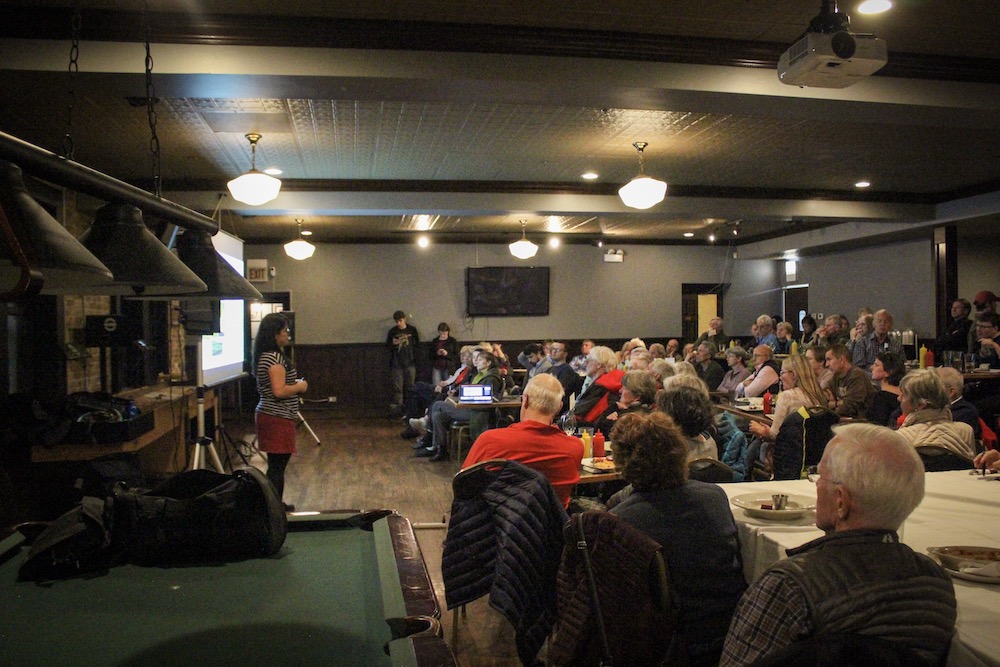By Selah Holland
Medill Reports
The American Lung Association declared Chicago the 18th most polluted U.S. city, with an ‘F’ rating for ozone pollution on the organization’s annual “State of the Air” report this year. Ozone levels rise with the heat index in summer and Chicago, like many cities, is seeing more heat waves.
This is one indicator that Chicago is facing serious climate change implications, said Northwestern University environmental researchers who are determined to do something about it.
Northwestern’s Climate Change Research Group (CCRG) leader Daniel Horton and researcher Irene Crisologo presented a climate action plan — Systems Approaches for Vulnerable Evaluation and Urban Resilience (SAVEUR) — to area residents in Evanston recently. An audience of more than 75 people learned about their plan and why it’s critically urgent.
We’re polluting the earth at a faster rate than we ever have before, said Horton, a climate scientist. Climate change has affected, and will continue to affect environmental factors such as temperature, rainfall, sea level, air quality, and other factors such as the extreme flooding in recent years in the Chicago area.
Between 1901 to 2016 there was a 42% increase in rainfall in Chicago, Crisologo said. Precipitation, she explained, has become a primary focus in the team’s research.
“I thought we had the monopoly on rain events [where I’m from], but apparently that’s not true,” joked Crisologo, a geologist and a native of the Philippines.
Traditionally, rain gauges have been the go-to for tracking precipitation. But Crisologo is dedicating part of her research to the incorporation of doppler radar, among other technologies to predict approaching weather events. The doppler effect is the reason we hear the sound of a train whistle as high-pitched when it is approaching and lower-pitched as it passes. The more rapid the change in pitch, the faster the train is going. Radar relies on electromagnetic waves to determine both the distance and speed of a weather event arriving. This can ultimately assist in making clearer, more nuanced climate predictions, she explained.
One of the larger goals of SAVEUR, Horton told the audience, is to find urban solutions to slowing climate change in a city such as Chicago. The basis of the solutions is in developing more green infrastructure, such as parks and gardens, since concrete soaks up so much heat and makes hot days seem even hotter.
Another vision is to spur incentives for people to switch to electric cars. Of course, the electric cars have to draw their battery power from renewable energy to make an effective and balanced difference, Horton said. Using electricity from power plants dependent on fossil fuels simply defeats the benefits of the electric vehicles in curbing climate change.
“If we switch over to electric vehicles, what we have are cars that don’t emit pollution” or carbon dioxide, he said. “We need to get that power from somewhere. In this case the power is coming from power generation stations, which means more pollution and more CO2 that’s coming from [some] power plants. Is this transition something that’s actually going to improve the air quality and the climate system?”
Carbon dioxide is a greenhouse gas that holds heat in the atmosphere, making CO2 emissions from burning gasoline and other fossil fuels the critical driver of climate change.
So what are the next steps to make Chicago a more environmentally friendly city? The Chicago Metropolitan Agency for Planning (CMAP) has developed a plan for 2050, which includes developing ecological infrastructure such as a new transportation system built to reduce traffic congestion.
But Horton believes a key and often overlooked part of making an environmental difference lies in behavioral change, which he said can be difficult to achieve.
“One of the reasons the SAVEUR project focuses so much on solutions as opposed to impacts is that we think there are solutions. And what they require is actual courage –– personal courage, and courage of our leaders. That’s what I think is missing in this whole climate change discussion––the courage side of this,” he said.

